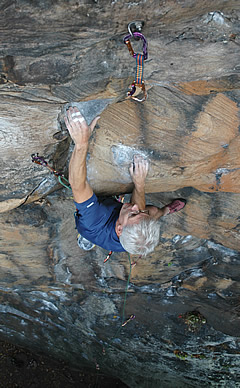The Best Training for Climbing Is...
 It's an old adage that "climbing is the best training for climbing," and many climbers use this line as an excuse for not engaging in any supplemental training activities. Let's examine this precept and determine, once and for all, if it is valid.
It's an old adage that "climbing is the best training for climbing," and many climbers use this line as an excuse for not engaging in any supplemental training activities. Let's examine this precept and determine, once and for all, if it is valid.When I am asked the question "Is climbing the best training for climbing?", my canned answer is "it depends." There are two sides of the training-for-climbing coin to consider: 1. in terms of improving climbing technique and mental skills, "climbing as training" is the only way to go, 2. developing high levels of sport-specific strength (i.e. grip strength, lock-off ability, upper-body power and such) demands supplement targeted training outside of just sending at the crags. Here's why.
The goals and course of effective action of "climbing" versus "training" are very different. For instance, the goal in climbing is to avoid muscular failure at all costs and, hopefully, reach the top of a boulder problem or climb. Conversely, effective training for climbing demands a stimulus of sufficient intensity to produce muscular failure in a few minutes (when training anaerobic endurance) and a few seconds (when training maximum strength and power). Summarizing--in climbing, you strive to avoid failure; in training, you need to pursue failure.
Another example that underscores the difference between climbing and training for climbing is the way in which you grip the rock. In climbing, the rock dictates a random use of many different grip positions and, at times, you may even deliberately vary the way you grip the rock. As a result, it's unlikely that any single grip position will ever get worked maximally and, therefore, the individual grip positions (e.g. crimp, open hand, pinch, etc.) are slow to increase strength. This should help you understand why a full season of climbing may indeed improve your local forearm endurance, but do little to increase you absolute maximum grip strength. Therefore, varying grip positions is a great strategy for maximizing endurance when climbing for performance, but it stinks for training maximum grip strength. Effective finger strength training demands you target a specific grip position and work it until failure.
As a final note, it may be best for some climbers to engage in physical conditioning that is not sport-specific in nature. For example, an overweight individual is better off spending some time performing aerobic exercise (and, of course, improve their dietary surveillance) rather than supplemental sport-specific climbing exercises. Likewise, someone lacking even modest "base strength" (i.e. unable to do even a few pull-ups, push-ups, abdominal crunches, etc.) is wise to engage in a period of standard circuit training to improve general conditioning.
In the final analysis, if you are serious about climbing performance you must not be satisfied simply "climbing for training", nor can you mindlessly adhere to old adages or train in the flawed ways as most other climbers do. Becoming the best (and strongest) climber possible demands that you become a knowledgeable, thoughtful practitioner of "training for climbing."
To learn more about training for climbing visit www.TrainingForClimbing.com.
Rick Fleming on Bubbaweiser (10d), New River Gorge, WV. Horst photo.



 Subscribe to Eric's RSS Feed
Subscribe to Eric's RSS Feed
 Subscribe to Eric's RSS Feed
Subscribe to Eric's RSS Feed